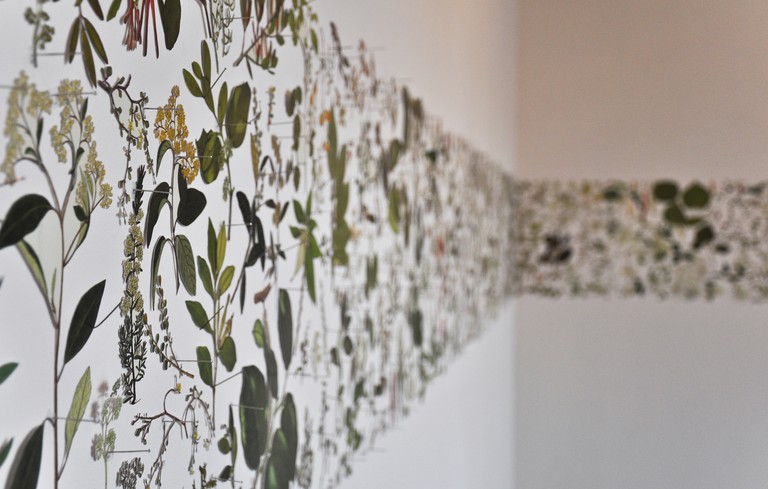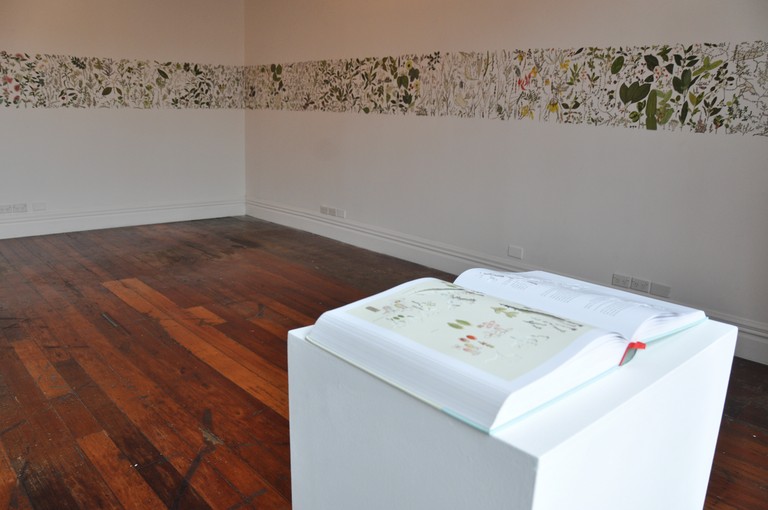Exhibition Essays
PODOCARPACEAE / Dacrycarpus - ASTERACEAE / Pachystegia
September 2010
PODOCARPACEAE / Dacrycarpus - ASTERACEAE / Pachystegia
Sian Torrington

I am an artist and a gardener. My art is akin to my gardening; organic, hard work and allowed to do it’s own thing. Every year I find new treasures, whether they be accidents of drawing or coriander seeds which have taken root through my lettuces. When I draw it is an intuitive, loose process. I do look at things but when I get bored I let my eye and hand wander, connecting what I have drawn with something else. It becomes a map of experience rather than a dedicated observation, and it connects everything. Like in the garden, all the plants have a relationship. When I plant calendula with tomatoes it keeps the bugs away, as well as looking pretty. In both practices there is also plenty of mystery. Last year I dug over two beds of clay. The earth was like rock, but encouraged by the thought of more growing space, I put cauliflowers in there to see if they would grow. We just harvested ten, as big as your head.
So, Gabrielle Amodeo’s show fascinated me. Cataloging, archiving and detailing painstakingly is not my forte. It’s a very different kind of looking to what I practise, one which involves separating things out, drawing or cutting them very carefully, and then storing them carefully too. I’m interested in what the relationship is of this dedicated looking, to the intricately tangled interconnected mass, which is native bush in the flesh.
Eagle says in the preface to the book:
There was always a plant coming home with me. In fact, at times, there were too many specimens to go in the refrigerator and the next coolest place, the bath, was employed to hold the excess specimens.1
Here is the mass which occurs when we tangle with nature, trying to separate it out into constituent parts. My gardening colleague calls it ‘moving deckchairs on the Titanic’, the constant holding back of weeds and seedlings when Wilton’s bush is just over the fence. This book took fifty years to make. Most of a lifetime. This show took Amodeo over a year to complete, and when I asked how she stored all of these cut outs she replied, filed in plastic folders. A tear across a leaf would be a tragedy. It takes us so long to imitate nature, to make something which approximates it. This is work, moving steadily and slowly towards an envisioned goal. Like these two artists making their work, organic growth moves slowly and determinedly, taking over everything in it’s path. Plants grow through cracks in the pavement, trees root in gutters. There are no boundaries to what might be the edge of one domain and the beginning of another. By cataloguing we cut things out, to try and see them apart from the overwhelming mass.

I recognise the fascination with nature, drawing, taking over spaces. I see this as a drawing show, one which has reformed an existing observation. Amodeo was given the book by her partner and decided to cut the images from it. She spoke about how the work collapses time; when you look at a book it is page after page, things are separate. This work releases the illustrations onto the wall and allows us to walk along them, to see them next to each other. But not overlapping. Her cut outs draw around the space of Enjoy, keeping within the boundaries of the four walls. The space they occupy is narrow and structured, like a border. No one plant or leaf reaches up or down outside the line. No one transgresses the boundary. I wonder about this decision. If the aim was to release the images from the book, then why not release them more fully, to expand and grow in different directions through the space. There is a dynamic here between control and release. To cut pages from a book has a transgressive feel to it, (though they are more often ripped) but this is done so carefully, with permission from the author. And yet this does at the same time feel like an extravagant visual feast. Perhaps because of the lack of pages, which piece out one plant at a time. Here you can look at everything at once or, as many viewers do, walk along the strip which is positioned at eye level. Positioned for your consumption, you can take in this lush unfolding along a prescribed path. The layout of the show makes you welcome in a way you are not necessarily if you were to go searching for this speci- mens. Eagle walked, tramped, gathered and brought home these specimens to put them into a book for us. Amodeo has then put them into a gallery for us. I assume that Amodeo, like Eagle, hopes that looking in this way will encourage us to then go back out to where these specimens grow, look for them, identify them and notice them. I understand that we like things in small packages, that a bulk block of cheese is not as attractive or desirable as a small, artisan version. I learnt this from working in kitchens, making chowders from enormous boxes of mussels, finding disgust for what is desirable in a small container. I think it is to do with what we can physically consume. I have had visitors from the UK who find New Zealand’s bush not beautiful but overwhelming in its hugeness, its middle of nowhereness.
Eagle was originally from the UK, and she describes her delight at the extent of the botanical species here, the sheer amount of names to learn and plants to discover. This was the impetus for the book, to draw in order to understand and learn names. This is human understanding, step by step, day by day gathering infor- mation and finding ways to remember it. For Eagle this was an active process, and Amodeo has also made her own active engagement with the book. She spoke of how working with this book made her connect with what was on her walks, about the excitement of recognising and realising she knew the name of the plant outside her window.
When I draw trees and plants they are almost blind drawings, wanting to respond to the movement of the leaf, the relationship of one leaf to another. And the impossibility of capturing the complexity of what I see. Trees grow on top of each other, they are pushy and layered and complex. The death of one means humus and nutrients for another hundred or two seedlings to crowd on, jump on board. It’s not that there isn’t order, just that there is a different kind of order. A logic of growth and expansion. Survival and continuing life. It is us that want to catalogue things, to archive them so we can see them. Like language, it is hard to relate to that which has no name. We want to describe, to catalogue, because it’s a way of engaging, of understanding.
Nature measures nothing. Nobody needs this much sunlight. Nobody needs droughts, volcanoes, monsoons, tornadoes either, but we get them, because our world is as extravagant as a world can be. We are the ones obsessed with measurement. The world just pours it out.2
Through this measurement many things can happen. Desires for neat gardens of roses in rows, or a sense that trees and leaves out there are really too messy as they are. We can start to see our own systems of order as preferable to what exists in its own order. Organic growth and nature does not sit in well behaved in rows within the pages of books or on walls. But this is how we need to look at it, for certain purposes and reasons. Eagle sees her contribution as conservation through better understanding; a reference book. It is not what nature is, but how it has been documented for us to better understand it in certain ways. Amodeo’s work is an active reflection of this. Drawing being a way of looking and paying attention, she has cut out these illustrations, looking carefully, intensely at them. This is a quiet, steady kind of looking in both Eagle and Amodeo’s work. Studied, careful and dedicated, they both set themselves tasks and worked to complete them. For Eagle it started with being out in the bush, collecting specimens, whereas Amodeo started with the book, then venturing out with her trained eye to look at what she found there. It is a kind of looking which separates, cuts out and hold up parts of a complex mass so that we may see and understand it better. And, before or after, goes out to see it in all of it’s complicated, interconnected, and chaotic glory.
